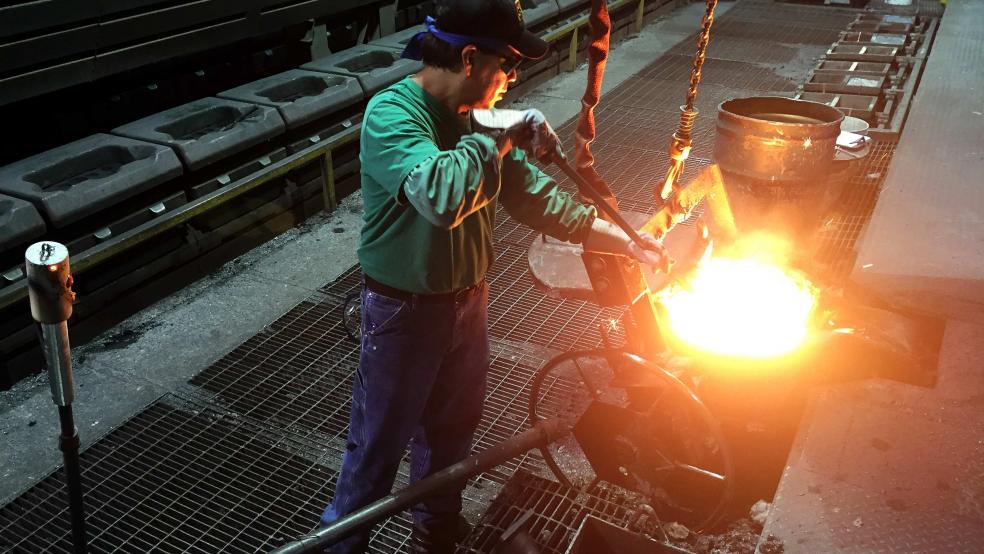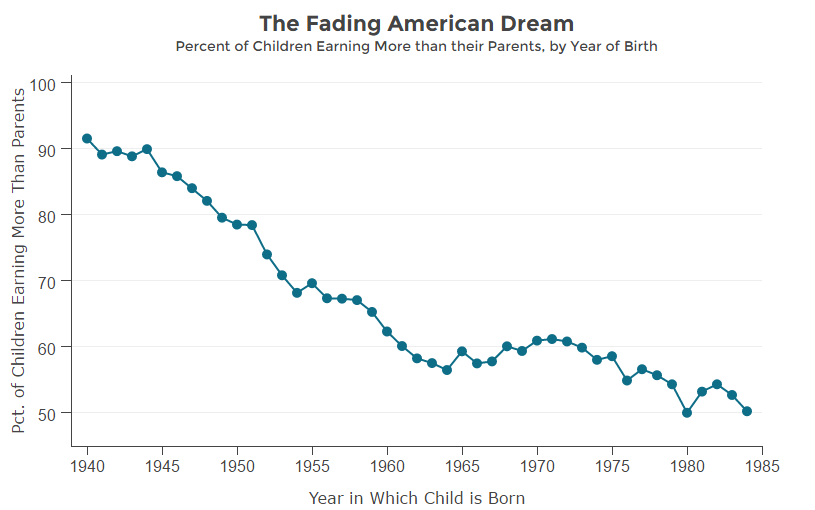While it’s never been exactly clear what President-elect Donald Trump really meant with his campaign promise to make America great again, for a considerable number of his followers it clearly spoke of a return to a time when jobs were plentiful, pay was enough to support a family, and the standard of living was rising for each new generation.
If that’s the standard Trump will be held to – revitalizing the American Dream, more or less -- new data suggests that the incoming president has a tougher job in front of him than he may have realized.
Related: The Campaign Promise Congress Won’t Let Trump Keep
Economists Raj Chetty of Stanford and Nathaniel Hendren of Harvard, through their Equality of Opportunity project, have documented the decades-long decline in economic mobility in the United States. One of the starkest findings: An American born in the 1940s had between 80 and 90 percent odds of earning more than their parents did during their lifetime. Children born in 1984 -- today’s 32-year-olds -- have just a 50 percent chance of doing better than their parents did.
To be sure, multiple factors contribute to individual’s lifetime earnings potential, and many Americans born in 1984 had barely begun their working lives when the Great Recession decimated the U.S. economy, setting back the economic fortunes of an entire generation.
However, the change over time is obvious and persistent, and according to Chetty and Hendren, it has a lot to do with the inequality of income in the U.S.
“Most of the decline is due to the more unequal distribution of economic growth in recent decades rather than the slowdown in GDP growth,” they write. “Increasing economic growth rates to the higher levels experienced in mid-century America would increase the fraction of children earning more than their parents to 62%. Spreading the existing growth more broadly across the income distribution would raise the level to 80%.”
Related: Just 40% of Americans Approve of Trump’s Cabinet Choices
Chetty and Hendren aren’t the only economists focusing on the stark changes in how the benefits of U.S. growth have been distributed over the past several decades. In a paper released earlier this week, economists Thomas Piketty of the Paris School of Economics, and Emmanuel Saez and Gabriel Zucman, both of the University of California Berkeley and the National Bureau of Economic Research, documented the way economic gains have accrued to the already-wealthy in vast disproportion since the 1980s.
“Average pre-tax national income per adult has increased 60% since 1980, but we find that it has stagnated for the bottom 50% of the distribution at about $16,000 a year. The pre-tax income of the middle class—adults between the median and the 90th percentile—has grown 40% since 1980, faster than what tax and survey data suggest, due in particular to the rise of tax-exempt fringe benefits. Income has boomed at the top: in 1980, top 1% adults earned on average 27 times more than bottom 50% adults, while they earn 81 times more today.”
This gets to a hard truth about the promises that Trump and his economic advisers have been making to the American public.
Trump, his nominee for Treasury Secretary Steve Mnuchin, his nominee to run the Commerce Department, Wilbur Ross, and other key figures on his transition team, have all spent time on television promising to drive up the country’s economic growth rate. Mnuchin, last week, said that he believes it is possible to crank up GDP to as much 4 percent per year.
Related: How Trump’s Cabinet Picks Are Payback to His Wealthy Pals
While many economists doubt that the country will see sustained growth at that rate – the Committee for a Responsible Federal Budget just released an analysis calling such growth “nearly impossible to achieve over a sustained period” -- the data gathered by economists researching the distribution of gains in the U.S. demonstrates that economic growth, all by itself, isn’t going to help the vast majority of low- and middle-income Americans achieve the American Dream, because they aren’t seeing the benefits of that growth in the first place.
There will be those who argue that redistributionist policies take some of those gains from the wealthy and pass them to the poor, but according to Piketty and his co-authors, “The government has offset only a small fraction of the increase in inequality.”
In the end, it will be up to individual voters to decide whether Trump’s economic policies really do make America great again. But if the goal is generation-by-generation increases in earning and standards of living, the incoming administration will have a very high bar to clear.






